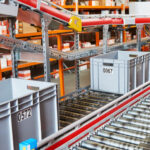Guide to Maintaining Food Hygiene
27 April 2024

Ensuring food hygiene and safety is non-negotiable in any culinary setting. Whether you’re a professional chef or an enthusiastic home cook, the responsibility of safeguarding the health of people who consume your food is of utmost importance. However, it can be challenging to stay up-to-date on the best practices, with regulations evolving and new risks emerging. This guide is designed to walk you through every facet of maintaining food hygiene and safety in your kitchen, empowering you with knowledge and tips that will protect your patrons and give you peace of mind.
Understanding the Basics of Food Hygiene
Before you can ensure the safety of your food, it’s crucial to understand what food hygiene is and why it’s so important. Consider doing the Level 3 Food Hygiene and Safety Course.
What is Food Hygiene?
Food hygiene is the practice of properly handling, preparing, and storing food to prevent infection and the spread of diseases. This includes maintaining a clean environment, personal hygiene, and avoiding cross-contamination.
The Importance of Food Hygiene
Neglecting food hygiene can result in foodborne illnesses, which cause sickness and can even be fatal. Hygiene standards not only prevent illness but also protect the reputation of food establishments and contribute to economic growth by reducing healthcare costs and boosting consumer confidence.
The Four Cs of Food Hygiene
The Four Cs of food hygiene are essential principles that act as a foundation for safe food handling. They consist of Cleaning, Cooking, Chilling, and Cross-contamination.
Cleaning
Maintaining a clean kitchen is not just about aesthetics; it’s about preventing the growth of harmful bacteria. This includes cleaning surfaces, utensils, and hands regularly and using separate cutting boards for raw meat and other foods.
Cooking
Proper cooking kills harmful bacteria that can cause foodborne illness. Utilize a food thermometer to ensure that foods reach their recommended internal temperatures.
Chilling
Refrigeration is a vital technique for keeping food safe. Store perishable foods below 40°F to slow the growth of bacteria.

Cross-contamination
Prevent cross-contamination by using separate equipment and storage for raw and cooked foods and by avoiding preparing these items in the same area.
Personal Hygiene in the Kitchen
One of the most critical components of food safety is practicing good personal hygiene. This means ensuring that anyone handling food, from chefs to servers, is healthy and follows strict cleanliness protocols.
Handwashing
Frequent and thorough handwashing is the frontline defense against harmful bacteria. Follow the WHO’s guidelines for washing hands properly and encourage your team to take the time to wash their hands with soap and warm water for at least 20 seconds.
Illness Policy
Develop and enforce a strict illness policy that prohibits individuals with stomach bugs or any contagious diseases from working with food. Provide adequate sick leave and promote a culture that values health over attendance.
Work Attire
Set clear expectations regarding the attire of kitchen staff. Proper attire should include clean, protective clothing such as aprons, head coverings, and non-slip shoes.
Safe Food Handling Practices
Safe food handling goes beyond the kitchen. It involves proper sourcing, transportation, and storage of your ingredients.
Supplier Selection
Choose suppliers that prioritize food safety and are transparent about their handling procedures. Check for certifications and ask about their standards.
Receiving and Transportation
Check the condition of food upon delivery. Ensure that cold items remain cold and hot items remain hot during transit to prevent spoilage and bacterial growth.
Storage
Proper storage conditions are key to maintaining food quality and safety. Utilize the FIFO (First-In, First-Out) method to ensure older products are used first and maintain a clean and organized storage area.
Implementing HACCP Principles
Hazard Analysis and Critical Control Points (HACCP) is a systematic preventative approach to food safety that addresses physical, chemical, and biological hazards. Implementing HACCP principles can help ensure food safety at every step of the process.
Identify Hazards
Conduct a thorough analysis to identify potential hazards that could be present in your food handling process.
Establish Control Measures
Once hazards are identified, establish control measures to prevent or minimize risks. This may include temperature controls, time limits for certain processes, or sanitation protocols.
Monitor Procedures
Consistently monitor these control measures to ensure they are being followed and are effective. Keep detailed records of your monitoring activities.
Corrective Actions
If a control point fails, have procedures in place to correct the issue and take appropriate actions to prevent the issue from occurring again.
Verification
Verify the effectiveness of your HACCP plan through regular reviews, testing, and audits.
Training Your Team
An informed team is your first line of defense against foodborne illness. Regular training sessions are crucial to keep them up-to-date with the latest food safety practices.
Initial Training
Provide comprehensive training to all employees as part of their onboarding process. Cover food safety basics, cleaning procedures, and personal hygiene practices.
Continuing Education
Offer regular training sessions to refresh and expand on what your team has learned. Changes in regulations, menu items, or equipment may necessitate additional education.
Lead by Example
Cultivate a culture of safety by demonstrating best practices yourself. Employees are more likely to follow the rules when they see managers and leaders taking them seriously.
Dealing with Food Allergies
Food allergies are a serious concern for many consumers. Educate your staff about the common allergens in your kitchen and stress the importance of accurate labeling and prevention of cross-contact.
Best practices for managing food allergies
- Clearly mark allergen-containing ingredients in your kitchen
- Ensure that staff members understand the severity of allergies and the importance of vigilance
- Have a protocol for handling allergic reactions, including emergency medical procedures if needed
- Regularly review and update your allergen protocols to reflect new information
Keeping the Kitchen and Equipment Clean
A clean kitchen is a safe kitchen. Regular cleaning and maintenance of equipment are necessary to prevent contamination and foodborne illnesses.
Daily Cleaning Routines
Develop and enforce a daily cleaning routine that covers all areas of the kitchen, from work surfaces to food storage areas.
Conclusion
Maintaining food hygiene and safety in your kitchen requires a combination of knowledge, preparation, and vigilance. By understanding the principles of food safety, training your team, and implementing comprehensive systems and procedures, you can both prevent foodborne illnesses and protect the reputation of your business. Remember, food safety is not a one-time effort but a continuous commitment to excellence in every aspect of your operation.





